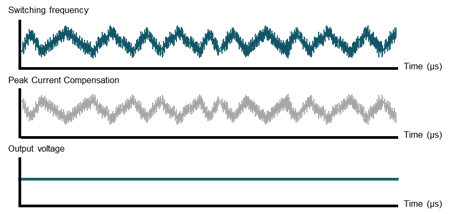Automotive systems have many regulations and requirements, from electromagnetic interference (EMI) to thermals to functional safety, but one consideration that stands above the rest when it comes to immediate consumer dissatisfaction is audible noise. In this technical article, I’ll discuss common sources of audible noise, and how devices with TI’s dual random spread spectrum (DRSS) technology can help you eliminate audible noise in your designs.
DRSS overview
The story starts with EMI. Automotive EMI standards are stringent, especially for switch-mode power supplies such as buck regulators. Buck regulators have many features that help reduce EMI, and one of the most popular is spread spectrum. TI DRSS technology uses advanced techniques to maximize spread-spectrum performance while eliminating many of the drawbacks of automotive traditional techniques. By using a combination of modified triangular and pseudorandom modulation, DRSS achieves the advantages of each technique while actively rejecting EMI in the audible band.
What is spread spectrum and how does it work?
All methods of spread spectrum dither the switching frequency of the power supply to spread the spectral content of the emissions. This can lower maximum emissions by around 10 dBµV. Spread spectrum does not reduce the amount of energy in the emissions; it simply spreads the emissions to provide more margin between the EMI waveform and the emissions limits. Figure 1 illustrates how this looks on an EMI plot. The low-frequency plot shows the spread of the first peak (the fundamental switching frequency) and the later harmonics start to blend together. The high-frequency plot shows that the harmonic peaks are now blended into an energy-averaged waveform, which provides more margin between the emissions and the red limit lines. But while spread spectrum helps spread the emissions of the switching frequency and harmonics, it introduces low-frequency emissions caused by the modulation dither frequency.
 Figure 1: EMI plot for a buck converter without spread spectrum (a) and with spread spectrum (b)
Figure 1: EMI plot for a buck converter without spread spectrum (a) and with spread spectrum (b)
Triangular modulation
Triangular modulation is a popular spread-spectrum scheme that dithers the switching frequency up and down in a triangle shape. The changing frequency causes the inductor ripple amplitude to change, however, which can cause output (and input) voltage ripple at the triangle frequency in peak- or valley-current-controlled devices. Unfortunately, the triangle frequency is usually between 4 kHz and 15 kHz, right in the audible region.
The audible frequency voltage ripple can generate audible noise in a few ways. The first way is for the ripple to induce physical movement in a ceramic capacitor (the electrostrictive effect) or inductor (loose windings), especially on a printed circuit board, which resonates near this frequency. Another way is capacitive or inductive coupling to nearby sound-generating circuitry, such as the input to an audio amplifier in a head unit. A third way is when the switch-mode power supply supplies power to an audio-generating subsystem, where the ripple may bleed into the audio output, depending on the amplifier specifications and headroom.
The 36-V 10-A LM61495-Q1 automotive buck converter and other devices with DRSS virtually eliminate these audible noise concerns. Not only does DRSS spread this audible-frequency noise from a tone to something more like white noise, but it actively rejects this audible-frequency noise before it has a chance to show up on the output voltage.
Figure 2 shows the building blocks of DRSS. TI started with triangular modulation to achieve great low-frequency performance, then modulated the triangle frequency to spread the audible tone peak into something more like white noise. Adding pseudorandom modulation optimizes the high-frequency spread.
 Figure 2: Building DRSS – triangular modulation of the triangular modulation, with pseudorandom modulation on top
Figure 2: Building DRSS – triangular modulation of the triangular modulation, with pseudorandom modulation on top
But that’s not all. Figure 3 illustrates an extra feature that actively works against emissions in the audible band. The audible frequency voltage ripple comes from the interaction between the inductor current ripple AC amplitude and the peak or valley current command. The finite loop gain causes imperfect tracking, resulting in an audible frequency ripple.
DRSS preemptively adjusts the peak current command based on the switching frequency at every switching cycle. In other words, as the inductor ripple amplitude changes, the peak current command has already shifted to maintain a steady average inductor current. This adjustment eliminates the output (and associated input) voltage ripple caused by the interaction between the spread-spectrum scheme and peak or valley current control.
 Figure 3: Peak current compensation follows the switching frequency to provide an output voltage with no additional spread-spectrum ripple
Figure 3: Peak current compensation follows the switching frequency to provide an output voltage with no additional spread-spectrum ripple
Conclusion
A buck converter with no audible frequency output ripple gives you the confidence that your capacitors and inductors won’t “sing.” You can create more compact layouts without worrying about audible noise coupling and supply power to sensitive audio equipment, even with little headroom. Picking a device with DRSS helps you achieve better spread-spectrum performance without concern for spread spectrum-induced audible noise, ensuring good EMI performance and a comfortable ride.









